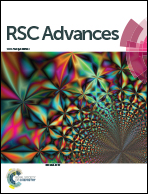Improved charge separation and transport efficiency in panchromatic-sensitized solar cells with co-sensitization of PbS/CdS/ZnS quantum dots and dye molecules†
Abstract
A panchromatic hybrid photoelectrode featuring co-sensitization of PbS quantum dots (QDs) and dye N719 with high charge separation efficiency was designed. In this photoelectrode, PbS QDs and N719 dye molecules exhibit a type-II energy level alignment, enabling efficient charge transfer between the two sensitizers and enhanced charge injection efficiency from sensitizers into TiO2, as confirmed by the significant PL quenching and time-resolved photoluminescence. Furthermore, we show the utility of a cobalt(II/III)-based redox electrolyte in solar cells based on PbS–N719 co-sensitized photoelectrodes, achieving a photovoltaic efficiency of over 2%. This result is comparable to the highest efficiencies obtained in cells of this type, and further verifies the important role of N719 as an intermediary agent in hole extraction from the PbS QDs. Compared to QD-only sensitized cells, co-sensitization significantly enhances the cell performance: the overall energy conversion efficiency by about 40% (from 1.55% to 2.12%) and the fill factor by about 20% (from 0.50 to 0.59). However, this system is still far from being optimal, and pathways towards its improvement are discussed.


 Please wait while we load your content...
Please wait while we load your content...